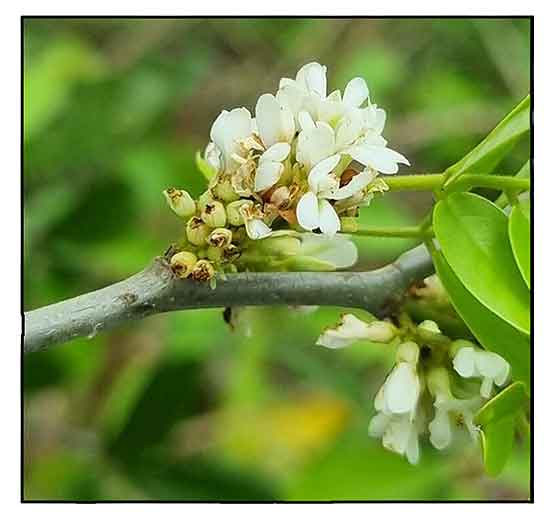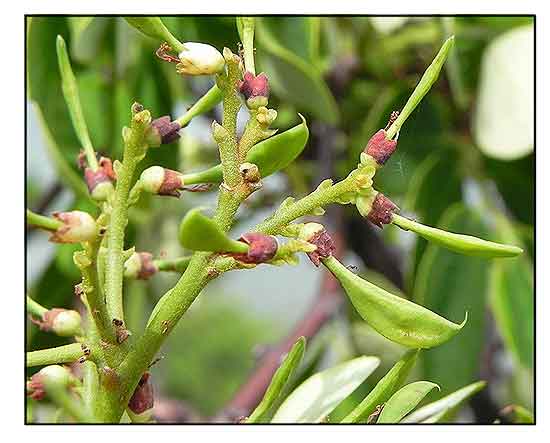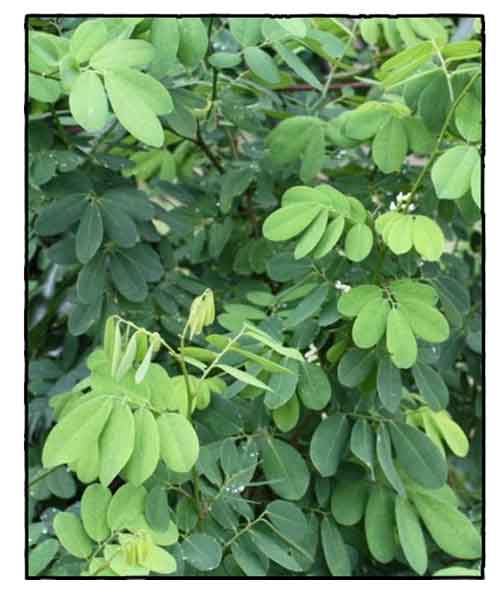Gen info
- Dalbergia is a large genus of small to medium-sized trees, shrubs, and lianas in the pea family, Fabaceae, subfamily Faboideae. (1) It contains between 293 and 375 species.
-
Dalbergia candenatensis is a species of liana in the family Fabaceae. It was first described by August Wilhelm Dennstedt but revised and reclassified by David Prain in 1901. (6)
 Botany Botany
• Scandent shrubs climbing by means of divaricate lateral twigs often hooked at the ends. Leaflets 5-7, 2-4.5 x 1-1.5 cm, elliptic to obovate, base acute, apex rounded or emarginate, sparsely adpressed hairy beneath; petiolules c. 2 mm long; rachis 2-5 cm long. Inflorescence a simple or branched raceme, 1.8-3.7 cm long, axillary and on lateral abbreviated branchlets. Flowers 5-8 mm long, white. Calyx c. 4 mm long; lobes rounded or obtuse. Petals with claws longer than the calyx; standard ovate, slightly auricled. Ovary linear, stipitate 1-2-ovuled. Pods 2-3 x 1-1.5 cm, falcate-lunate, flat, acute, thick, 1-seeded. Seeds reniform, compressed. (2)
• Scandent shrub or woody climber 3–5 m long; young shoots and inflorescences puberulous to pubescent. Stipules small, caducous. Leaves 5–15 cm long; petioles 1–2 cm long; rachis 2–10 cm long, glabrous to glabrescent. Leaflets 5–7, obovate, 1.5–5 by 1–3 cm, apex rounded, truncate to emarginate, base obtuse, upper surface glabrous, lower surface puberulous; lateral veins 5–7 pairs, thin, distinct on both surfaces, reticulation visible on lower surface; petiolules 1–3 mm long. Inflorescences axillary, racemose, 1–5 cm long; bracts ovate, ca 0.8 by 0.5 mm, acute, persistent; bracteoles elliptic, ca 1.5 by 1 mm, persistent; pedicels ca 1.5 mm, long. Calyx ca 4.5 mm long, glabrous. Corolla white; standard oblong, ca 3.5 by 2.5 mm, emarginate, claw ca 3 mm long; wings ca 3.5 by 1.5 mm, claw ca 3 mm long; keel ca 4 by 2.5 mm, claw ca 3 mm long. Stamens 10, in one bundle. Ovary glabrous; ovules 1–2. Pods falcate, ca 2.5 by 1 cm, glabrous, 1-seeded. Seeds reniform, ca 8 by 15 mm, reddish brown. (e-Flora of Thailand)
Distribution
- Native to the Philippines.
- From Luzon to Mindanao. In tidal stream thickets subject to influence of salt or brackish water.
- Also native to Andaman Is., Bangladesh, Bismarck Archipelago, Borneo, Cambodia, Caroline Is., China Southeast, Fiji, India, Jawa, Malaya, Maluku, Marianas, Myanmar, Nansei-shoto, New Caledonia, New Guinea, Nicobar Is., Northern Territory, Queensland, Solomon Is., Sri Lanka, Sulawesi, Sumatera, Thailand, Tonga, Vanuatu, Vietnam. (1)
- Common in mangrove forests, rocky beaches, river banks near the sea.
 Constituents Constituents
- Study of extract of leaves yielded phenolics, flavonoids, and tannin, quantified as 416.25 mg, 330.00 mg, and 432.22 mg Gallic Acid Equivalent/100 g dry extract, respectively. (see study below) (4)
- Study of CH2Cl2 extract of D. candenatensis heartwood yielded six phenolic compounds, designated as candenatenins A-F (1-6), along with four known compounds, (2R,3R)-3,5-dihydroxy-7-methoxyflavanone (7), 4-hydroxy-3-methoxy-8,9-methylenedioxypterocarpan (8), nutiducol (9), and sophoraflavanone A (10).
(5)
- Study of acetone extract of air-dried heartwood isolated five new phenolic compounds, candenatenins G-K, along with four known compounds, dinklagin A (6), stipulin (7), (R)-4-methoxydalbergione (8), and lelilotocarpan A (9). (see study below) (7)
-
Study of heartwood isolated a labile, purple pigment. candenatone, from a complex mixture of closely related orange and purple pigments. Preliminary evidence suggested the compound was an isoflavone with an additional C15 unit attached. (8)
- Study of heartwood isolated five isoflavonoids, including a new isoflavone quinone, 5-hydroxybow-dichione.
Four of the isolated compounds were identified as (±)-mucronulatol, (R)-(-)-claussequinone, formononetin, and (R)-(-)-vestitol. (see study below) (13)
 Properties Properties
- Studies have suggested membrane stabilizing, anticoagulant, depression, analgesic, cytotoxicity, antioxidant, anti-inflammatory, anti-estrogenic properties.
Parts used
Leaves, heartwood.
Uses
Edibility
- No information found on edibility.
Folkloric
- No reported folkloric medicinal use in the Philippines.
- In Fiji, used for backache and internal boils. (10)
- In Bangladesh, wood is used as blood tonic, expectorant, antifungal and antibacterial. (4)
Others
- Dye: Heartwood has a deep red color, used in Thailand as red dyestuff.
Studies
• Pharmacologic Potential / Leaves: Study evaluated the membrane stabilizing, anticoagulant, analgesic, cytotoxic, anti-inflammation, and depressive potentials of D. candenatensis leaves metabolites. Analgesic action, cytotoxic effect and subacute anti-inflammatory activities were determined by acetic acid induced writhing model, brine shrimp lethality bioassay, and formaldehyde induced model, respectively. Depression activity was evaluated by Open Field, Hole Cross, and thiopentone induced sleeping time methods, and anticoagulant property by prothrombin time test. Extract showed maximum inhibition of writhe, hemolysis, and edema, approximately 57.14%, 36.62%, and 34.10%, respectively. LC50 value for nauplii was 151.499 µg/ml. Mean prothrombin time was approximately 31.0 sec at 1.0 mg/ml. Extract showed depression activity, with maximum sleeping time of about 141 minutes. Results showed dose-dependent membrane stabilizing, anticoagulant, CNS depressant, analgesic, moderate cytotoxic, and subacute anti-inflammatory activities. (4)
• Acute Toxicity Study / Leaves: Acute toxicity study of ethanol extract of leaves using OECD guidelines orally administered doses of 500, 1,000, 1,600, and 2,000 mg/kbw of mice. The extract showed no mortality or side effect at highest dose of 2000 mg. (4)
• Cytotoxicity / Antioxidant / Heartwood: Study of acetone extract of air-dried heartwood isolated five new phenolic compounds, candenatenins G-K, along with four known compounds. Compound 5 showed potent activity against DPPH radical scavenging with IC50 of 25.7 µM. Compound 2 showed cytotoxicity against NCI-H187 cell line with IC50 of 14.8 µM. (see constituents above) (7)
• Antiestrogenic Activity: Study evaluated methanol extracts of 40 plants from Egyptian and Thailand folk medicines for estrogen agonist and antagonist activities. Estrogenic and antiestrogenic effects were carried out using the yeast two-hybrid assay system expressing ERα and ERß. The most potent antiestrogenic effect was shown by Aframomum melegueta, Dalbergia candenatensis, Dracena loureiri, and Mansonia gagei. Dalbergia candenatensis revealed significant estrogenic activity activity on ERß only. (11)
• Antimicrobial / Cytotoxicity / Isoflavonoids / Heartwood: Study of heartwood isolated five isoflavonoids, including a new isoflavone quinone, 5-hydroxybow-dichione. CHCl3 and MeOH extracts were found to exhibit antibacterial and antifungal properties. The same extracts showed cytotoxicity activity against P-388 lymphocytic leukemia test invitro. (see constituents above) (13)
Availability
Wild-crafted.
|

![]()






